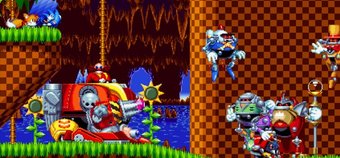There aren't many games like Unravel. A side-scrolling platform game, with a huge emphasis on solving physics based puzzles, it almost feels like a modern take on a mascot driven platform game, only for an older audience. And that's not because it deals with any particularly mature subject matters - but because of how it's going to tax your brain.
Following the story of the imaginatively named Yarny, Unravel's levels see the world from a very different perspective. Kind of like Little Big Planet, in that you're a very small creature in a very large world (or, if anyone else remembers it, the GameCube tech demo, Rebirth), each level sees your little woolly friend start out tethered to an initial starting point - and, as you start to make your way through the level, you'll begin to unravel (three guesses as to where the game got its name). And, though it may not seem it, your limited reach is actually key to the gameplay.
The puzzles in Unravel come thick and fast, and almost all revolve around using some sort of rudimentary knowledge of physics. Pressing square (on PS4) lets you tie a knot in your string around certain objects, and this knot can be used in many ways. At the most basic level, if you drop off a ledge and hold L2, you'll start pulling yourself back towards the thing you tethered yourself too, and so you can create your own rope swings to reach new areas. If there are two sparkling tether points fairly close together, tying yourself to both of them lets you create your own rope bridge, which you can either walk up, or use as a giant springboard to reach higher ground. You'll need to keep a close eye out for these tether points, as you'll really struggle to get through the game without them.
Pressing R2 lets you fling your string out like a lasso, and swing from various tether points like a woollen version of Tarzan, while holding circle, lets you drag certain objects you find lying around - from tin cans to batteries and old, rotten branches, you can shuffle certain things around in the environment to your heart's content - it's just figuring out how to use them that's the problem. Sometimes you'll just need to force it up against a ledge to use as a makeshift platform - or, if it's a piece of wood, you might need to make a bridge using your string, then push the plank up it, and into a nearby lake, so you can set sail, and continue your adventure. With puzzles coming thick and fast, you'll constantly find yourself having to pause, look around, and try and figure out what you need to do to carry on.
And that's where the genius of Unravel comes from. Because there are no "special" mechanics to discover, everything works as it would in real life - so, if you could figure out a way to get your little yarn man from A to B in real life, the chances are you can do it in game too. And while creating your own rope bridges, and shoving things around it may form the game's bread and butter, the puzzles do very quickly get a lot trickier. Just take a look at the thinking involved to solve the puzzle below, and you'll get the gist of how complex things can get (in a good way).
And because you're constantly unravelling, how you manage your yarn becomes a real factor in how you solve the puzzles. Scattered throughout the levels, you'll find the odd yarn replenishing checkpoint - yet if you've left yourself tethered to the last puzzle, or solved it in a particularly awkward, back and forth way, you'll have left behind more yarn than you should have, and you'll end up running out before you get to the next checkpoint - meaning you'll have to go and back track.
So, there's a lot to think about in Unravel - yet that's part of what makes it so rewarding. Taking a look at the objects you're presented with, and figuring out how to tie everything together, literally, leaves you with a real sense of accomplishment when you figure it out - and there are so many "ohhhhhhh!" moments, where you'll finally figure out what you're meant to be doing, after several minutes of messing around. When it all comes together, it's great.
It's a genuinely gorgeous game, too, with lush green forest floors to explore, deep snow to wade shoulder-deep through, while the game also has an incredible ability to make you shiver in real life when the cold wind blows in game. There's a real sense of scale, too, as poor Yarny is dwarfed by even a drink can, and whether you're bouncing off a giant mushroom, rolling a snowball that's twice the size of your woollen mascot, or coming across the odd creature (crabs, crows, a rat-type thing), which are almost always several times your size, it gives you a real sense of awe and wonder as you wander round the worlds. The well hidden collectible badges give you the perfect excuse to play through the levels a few more times, too, and see how much you missed.
However, while the puzzles can all be solved through real-world thinking, it is a little bit naff that the game doesn't give you anything in the way of any assistance when it comes to solving them. Especially towards the end of the game (one of, if not the final puzzle, which involves pushing a lantern up a hill, tethering it when the wind blows, had us stumped for days), the solutions get that much more convoluted, and, disappointingly, there's no hint system built in - so if you come up against a puzzle you can't solve, it's off to the internet for you, to scour the web for a solution. Having some sort of built in prompt would have made things a lot more accessible - but unfortunately, it doesn't seem like the developers thought very much about accessibility when they started work on Unravel.
As a case in point, there's nothing to let you know when you're actually in control - the game starts with a brief cutscene, which seamlessly transitions into the game, and lets you take control - it just doesn't tell you when. Lots of games seem to be doing this now, but if we had a penny for the number of times we've just sat there for a few seconds, wondering why nothing's happening, before we realise the game's officially started, we'd have at least 10p. Meanwhile, the game's level select screen is a disappointing example of complexity created through an effort to keep things simple, as, rather than simply having you choose from a list, you can only access the levels by first finding certain picture frames in the house. The only problem is, that makes it easy to miss levels - especially if it takes you as long as it took us to realise that there's more than one room you can explore in the house, and a whole extra set of levels you might not find. It's much more awkward than it needs to be.
Similarly, there's the odd bit of awkwardness in Unravel's levels, too. Some sections are unnecessarily tricky, and require the frustrating pixel-perfect platforming of old - trying to skip across some bits of moss and wood that are floating in a swamp, when hanging around for more than a second or so drops poor Yarny into the water (and his inevitable demise) really isn't that much fun. Similarly, there's a few bits that see you "flying", holding on to a kite, or a bag or something. When we first went hands-on with Unravel at last year's gamescom in Germany, we watched every single person in the room attempt this one flying section, and fail, because nothing told them how it worked - and you will too, if you grab on to the kite/bag, and start flying. No sooner will you have took off, than you'll start plummeting to the ground - because nothing tells you what to do. Push up, and you'll take Yarny closer to the bag, and lead yourself to your demise that much quicker. It turns out, what it want you to do is extend the length of the string you're hanging from, by pushing down. So when you see yourself heading towards the forest floor, and want to go up, you need to hold down. Apparently, despite having seen everyone flop straight to the floor at gamescom, the developers decided there were no changes needed. Hmm.
Still, despite its flaws, and the odd awkward section, Unravel is the sort of game you can't help but recommend to friends and family - and one you'll want to play through to completion. While it could really use a few tweaks to make it that little bit more accessible, if you like a bit of puzzle with your platformer, Unravel is well worth picking up. You won't regret it.
Format Reviewed: Playstation 4



















